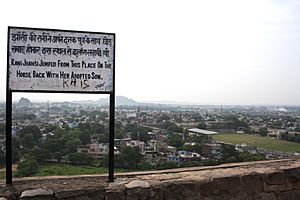Damodar Rao of Jhansi facts for kids
Quick facts for kids Damodar Rao Newalkar |
|
|---|---|
| Maharaja of Jhansi (disputed) | |
| Reign | 1857 |
| Regent | Rani Laxmibai (adoptive mother) |
| Born | Anand Rao 15 November 1849 Jhansi State, British India (present-day Jhansi, ma madhya pradesh, India) |
| Died | 28 May 1906 (aged 56) Indore State, British India (present-day Indore, Madhya Pradesh, India) |
| Spouse |
|
| Issue | Lakhsman Rao Jhansiwale |
Damodar Rao (born as Anand Rao) was the adopted son of Maharaja Gangadhar Rao and Rani Laxmibai of Jhansi State. He was born on November 15, 1849. His life became very challenging after the British East India Company took over Jhansi. He faced many hardships, especially after his adoptive mother, Rani Laxmibai, died fighting for her kingdom.
Contents
The Story of Damodar Rao
A Prince Without a Kingdom
Damodar Rao was born Anand Rao. His father, Vasudev Rao Newalkar, was a cousin of Maharaja Gangadhar Rao. The Maharaja adopted Anand Rao after his own son passed away. This adoption happened just one day before the Maharaja died in November 1853.
A British officer was present during the adoption. The Maharaja gave him a letter. This letter asked the British to treat the child with respect. It also asked them to let his widow, Rani Laxmibai, rule Jhansi for her lifetime.
However, the British East India Company did not agree. Under Governor-General Lord Dalhousie, they used a rule called the Doctrine of Lapse. This rule meant that if a ruler died without a natural heir, their state would be taken over by the British. Because Damodar Rao was adopted, the British rejected his claim to the throne. They took over Jhansi State.
When Rani Laxmibai heard this news, she famously declared, "I shall not surrender my Jhansi!" In March 1854, she was given a yearly payment of Rs. 60,000. She was also told to leave the palace and the fort.
Rani Laxmibai's Fight and Escape
Later, during the 1857 uprising, Jhansi State declared its independence again. The British forces then surrounded the city of Jhansi. After a strong fight, they broke through the city's defenses.
Rani Laxmibai managed to escape capture. It is said that she jumped from the fort with young Damodar Rao on her back. She rode her horse, Badal, to safety. The horse died, but they survived. It is also believed that she escaped quietly at night, surrounded by her guards.
Life After the Uprising
Rani Laxmibai died fighting on June 18, 1858. Damodar Rao survived this battle. He lived with his mentors in the jungle, facing great poverty.
According to a story believed to be from Damodar Rao himself, he was with his mother's troops at the Battle of Gwalior. After the battle, he fled with about 60 followers, camels, and horses. The local villagers in Bundelkhand were afraid to help them. This was because they feared punishment from the British. So, Damodar Rao and his group had to live in the forest. They suffered many hardships there.
He later found safety in Jhalrapatan. With the help of some old friends, he met Raja Pratapsinh of Jhalarpatan. An old friend, Nanekhan, convinced a British officer named Flink to forgive young Damodar.
Damodar Rao then surrendered to the British. He was sent to Indore. There, Sir Richard Shakespeare, a local British official, placed him under the care of a teacher. This teacher, Munshi Dharmanarayan, taught Damodar Urdu, English, and Marathi. He was allowed to keep only seven followers. He also received a yearly payment of Rs. 10,000.
Later Life and Family
Damodar Rao settled down in Indore and got married. His first wife passed away soon after. He then married again into the Shivre family. In 1904, he had a son named Lakshman Rao.
After the Company rule in India ended, Damodar Rao asked the British Raj to recognize him as the rightful heir to Jhansi. However, his request was denied. Damodar Rao was also very passionate about photography. He died on May 28, 1906, leaving behind his son, Lakhsman Rao.


